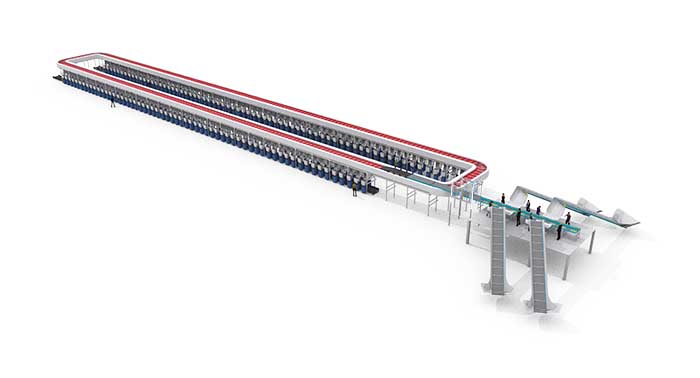What is a sorting system?
Home » What is a sorting system?
In this article we will cover the basics of sorting systems. We will get to know their purpose, applications, benefits, and the different types that are used in warehouses today.
Sorting systems are material handling systems used to sort items in warehouses or distribution centers. Sorting is often based on the destination of the items. The logic in which they are sorted depends on the type of company or application within the supply chain. Some examples:
- Postal or courier companies could use an outbound sorter to sort by routes or postal code to gather all items for the drivers.
- Brick and mortar companies often sort the items to physical stores.
- E-commerce orders can be sorted directly to orders, or if the amount of orders is very large, a combined batch of orders. This last option needs a second sorting process to fine sort the items per order. This fine sorting could be done by using put-to-light cabinets or another manual sorting system like scan-to-sort.
Within the supply chain, the sorter can be used for various applications to bring more efficiency. Typical stages within the supply chain where a sorter can be used include inbound, return, outbound or shipping.
Manual, semi-automatic or automatic sorting
Sorters come in a large variety. Automatic sorters range from conveyor-based sorters like the cross-track sorter to carrier-based sorters like the LR-sorter, slide tray sorter, or bomb-bay sorter. Based on aspects like the required capacity and the available budget, the choice might be made to select a manual sorting system or (semi-)automatic sorting system. The full list of sorter types is endless and constantly evolving, but the most common types include:
(Semi-)automatic sorting
- Split tray sorter (bomb-bay sorter)
- Slide tray sorter
- Vertical sorter (LR-sorter)
- Cross-track sorter
- Crossbelt sorter
- Tilt tray sorter
- Pop-up sorter
- Pusher sorter
Manual sorting

The process
Sorters do have one thing in common: the process that they support and the steps they take to fulfill that process. It starts with the infeed of items, also known as picking. The items are gathered from the warehouse, inventory, or couriers and are transported to the induction zone. The items are then identified and fed into the sorter, a process that can be executed manually or automatically. The image above shows an example of an automatic infeed with a paddle belt. Operators receive a constant flow of items via the paddle belt and put the items on a conveyor, on which items are automatically scanned before entering the sorter. The image below shows a slide tray sorter with a manual infeed zone where operators scan the products before putting them directly into the sorter.
